8 Yoga Poses for When Your Energy Needs a Boost
This article originally appeared on Yoga Journal
I'm not sure if I remember a time when I wasn't tired. Yes, I have two very young children, so I'm sure I am especially exhausted now. But even before I met my husband, I would often wonder what it was like to feel fully rested. We can be tired for so many reasons. Sometimes it's not as simple as not sleeping poorly or not enough. Subtle contributors to fatigue include everything from anemia and vitamin deficiencies to dehydration and even depression.
Our approach to asana could be another contributor to our fatigue. We attend strong vinyasa flow classes when our "energy tank" is on fumes, and then wonder why the practice didn't help us feel better. Or we take a class late in the day that's so stimulating it leaves us both tired and wired.
The prescription for regaining energy is to balance things out. This sequence is designed to both slow things down to honor the exhaustion, and to rev up certain aspects of the practice to elevate mood. Remember we are not looking to feel like we're amped up on ten cups of coffee. Sustainable energy is a lot more subtle than that. You want to be both alert and reposed.
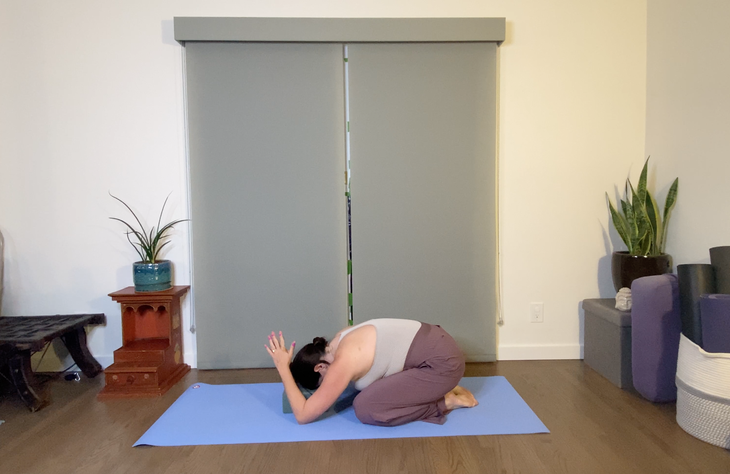
1. Balasana (Child's pose), variation
It can seem counterintuitive to start in a pose that may make you want to go to sleep, but Child's Pose can be an opportunity to meet yourself where you are. Having your elbows bent and your heart melting toward the ground is a tease of the deeper backbending to come. This variation is the best of both worlds--both calming and activating. It's the pause before the action.
How to: Come onto your knees. Bring your big toes together and separate your knees. Set a block in front of you. Fold over your thighs and place your forehead on the block, adjusting it to a height that allows your head to be in line with your hips. Reach your arms out in front of you alongside your ears. Bend your elbows and lift your hands and forearms off the floor, bringing your palms with your fingertips pointing skyward. Imagine you could press your armpits to the floor as you reach your chest forward. Soften the muscles of your upper back. Keep your bum heavy to counter the heart opening. If you are very mobile in your upper back and shoulders, you can elevate your elbows onto blocks for more of a back bend. Remain here for 10 long breaths.
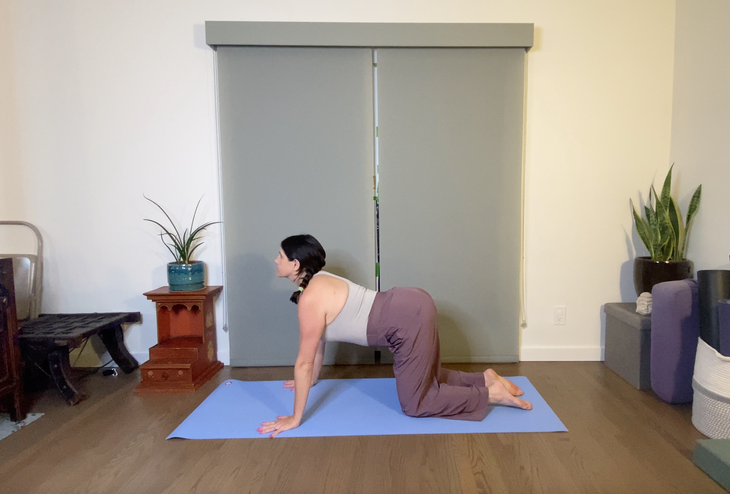
2. Bitilasana/Marjaryasana (Cat/Cow Pose)
One benefit of practicing Cat/Cow early in a sequence is that it helps you begin to energize your body. Movement increases oxygen circulation, which supports the body's overall use and maintenance of energy. It can also ignite feel-good hormones, such as dopamine and endorphins. Here, we will focus on the area of the lungs. Add in the mindfulness aspect of pairing breath to action and you have the perfect energy-boosting cocktail.
How to: From Child's Pose, inhale as you come up into Tabletop position. Align your wrists beneath your shoulders and knees under your hips. On an inhalation, lift your head and chest into Cow. Lift your chest toward your chin as your bum lengthens back. On an exhalation, press your palms strongly into the floor and dome your back into Cat. Here, focus on spreading your shoulder blades apart and widening your upper back. Repeat each of these movements for five cycles with awareness of this area of the lungs.
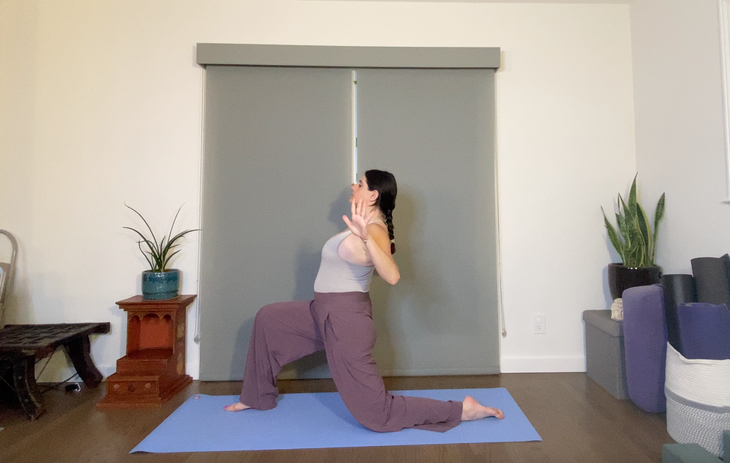
3. Low Lunge, variation
Backbending postures are thought to help boost energy by stimulating our adrenals, the glands that regulate many of the body's autonomic processes including blood pressure, mood, and immunity. They are also key players in our stress response. Sitting on top of our kidneys just at the line of our lower ribs, the adrenals share fascia (connective-tissue) with the psoas muscles, one of the main hip flexors. According to Liz Koch, author of The Psoas Book, "a chronically tightened psoas continually signals your body that you're in danger, eventually exhausting the adrenal glands and depleting the immune system." This is why psoas lengthening poses like Low Lunge can be effective stress-reducers.
How to: From Tabletop, curl your toes under and press your hips up into Adho Mukha Svanasana (Downward Facing Dog) for a few breaths first. On an inhalation, lift your right leg. Exhale and step your right foot forward between your hands. (You may need to use your hands first to nudge it there.) Lower your left knee to the mat. Place a folded blanket under your knee and shin if you have any sensitivity. Inhale, lift your torso upright and reach your arms up in line with your ears. On an exhalation, bend your elbows and squeeze your shoulder blades together behind you. Inhale, stretch your arms back up. Continue this flow for five full breaths. After your fifth round, fold forward, place your hands on the floor, and step back to Downward Dog. Repeat on the opposite side.
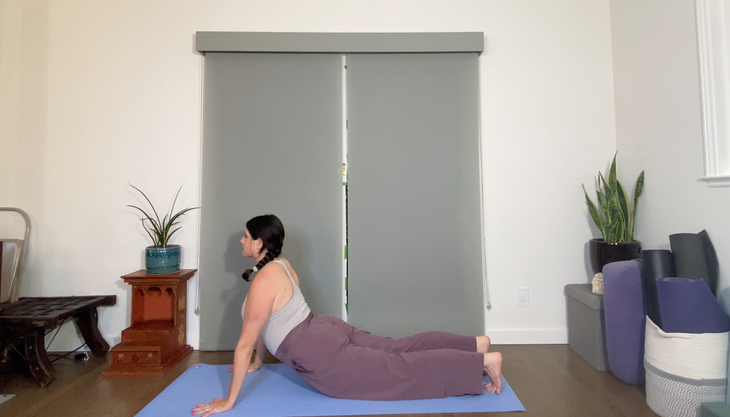
4. Urdhva Mukha Svanasana (Upward Facing Dog Pose), variation
This version of Upward Facing Dog will continue the work of the previous pose, lengthening the psoas while stimulating the adrenals. Curling your toes under enables you to activate your legs in a more accessible way than when we are pressing into the tops of our feet. Sometimes we have to give energy to get energy!
How to: From Downward Dog inhale and bring yourself forward into a Plank position, with your wrists below your shoulders and feet hip-width apart. If full Plank is too intense, you can place your knees down on the mat. Press your palms strongly into the mat and lift your chest as you drop your pelvis toward the floor. Widen your collarbone and drop your shoulders away from your ears. If you feel any wrist sensitivity, practice with your hands on blocks. Stay here for five breaths. On an exhalation come back to Downward Dog.
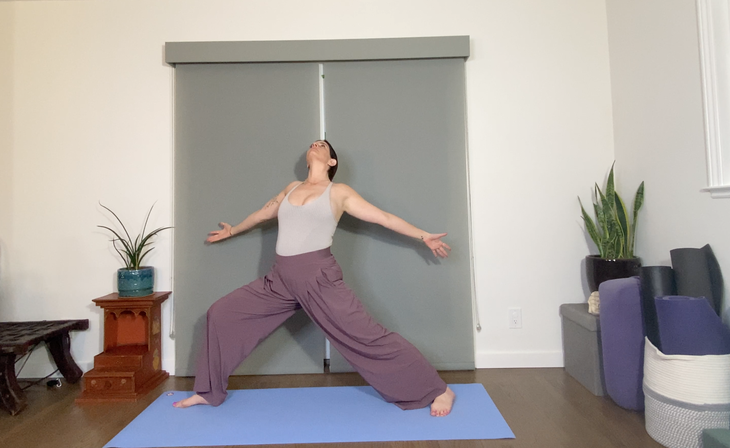
5. Virabhadrasana 2 (Warrior 2 Pose), variation
Energy doesn't only come from movement; it can come from stillness, too. Virabhadrasana 2 allows you to anchor into the power of your legs, while using our arms to open your chest and heart. This arm variation gives you a mild backbend. The slight twist of the trunk in Warrior 2 can be energetically refreshing. Sometimes energy is just stuck and needs to be uncovered and unleashed.
How to: From Downward Facing Dog, inhale and lift your right leg to the sky. On an exhalation, step your right foot as far toward the front of your mat as possible. Turn your left toes out slightly and create a line from heel to heel. Firm your right hip and windmill your torso upright into Warrior 2 pose, with your arms extended parallel to the floor. (You will be facing the long edge of the mat.) Align your right knee over your right heel and ankle. Externally rotate your upper arms and turn your palms up to the ceiling. On an inhalation, lift through your heart and draw your arms back exaggerating the lift in your chest. On an exhalation, lengthen through your spine. Maybe even take your head back and look up. Stay here for eight breaths. Turn your torso and windmill your hands to the floor on either side of your front foot. Consider taking the vinyasa sequence of Chaturanga to Upward Facing Dog, before returning to Downward Dog and setting up for your second side.
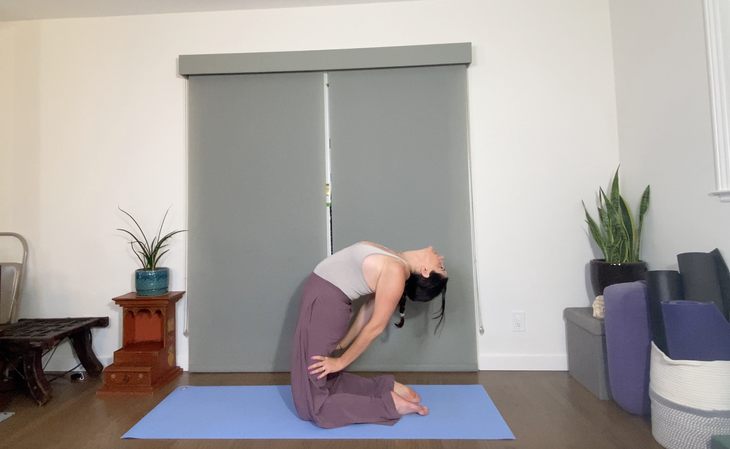
6. Ustrasana (Camel Pose), variation
While this pose is generally categorized as a variation of Camel, it is equally a variation of Laghu Vajrasana, which translates to "little thunderbolt" in English. Part of what makes this little thunderbolt so charged is the leg strength required to support you in bending backward safely. You need a foundation of grounding and support, if you are to have energy.
How to: From Downward Facing Dog, lower your knees to the mat, separating your legs and feet hip width apart. Lift your torso and come up to stand on your knees. Bring your hands to your sacrum. On an inhalation, lengthen your spine from tail to crown; on an exhalation, arch your back. Then lean back feeling the stretch along the front of your thighs. Continue to lift your chest and let your head reach back as though you could place your crown onto your feet. Slide your hands down the back of your leg, just beneath your bum. Pause for a full breath cycle. Inhale and use the strength of your legs to bring your body back upright. Sit back on your heels and pause. Repeat two more rounds.
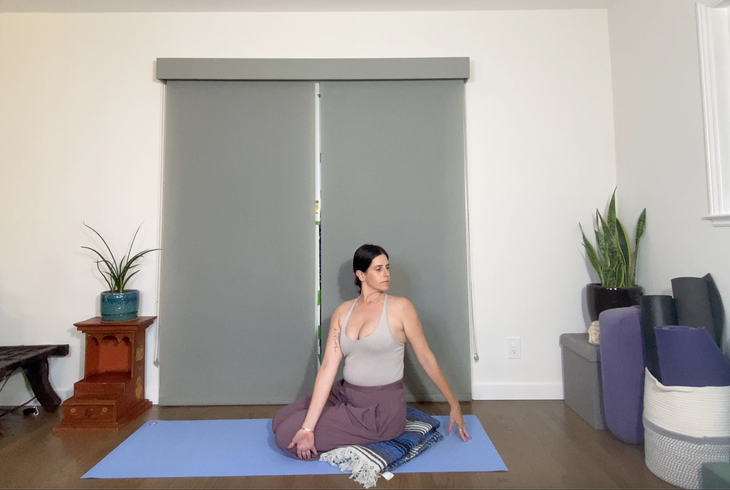
7. Bharadvajasana (Bharadvaja's Twist)
Twists are considered neutralizers for the spine. They are a nice transition pose after extreme movements and a good way to unwind, literally. This sequence has required a lot of spinal extension work, backbending in the majority of poses. This seated twist will help bring your spine (and energy) back to a more balanced place.
How to: Come to Tabletop and bring your knees, shins, and feet together. Place the top of your left foot into your right foot's arch. Shift your hips off to the left and back toward your heels, coming to sit on the mat with your ankles and shins on the right. If you feel unbalanced, place a blanket under your left outer hip and thigh. Take your right arm across your body and press the back of your right hand into the outside of your left thigh. Inhale and lengthen your spine; exhale and twist to your left. Support yourself on your left fingertips or by bringing your left hand to a block. Keep your chin level and only turn your head as far as your torso is able to twist. Stay here for five rounds of breath. On an exhale, unwind your spine. Press back up onto your knees and set up for your second side.
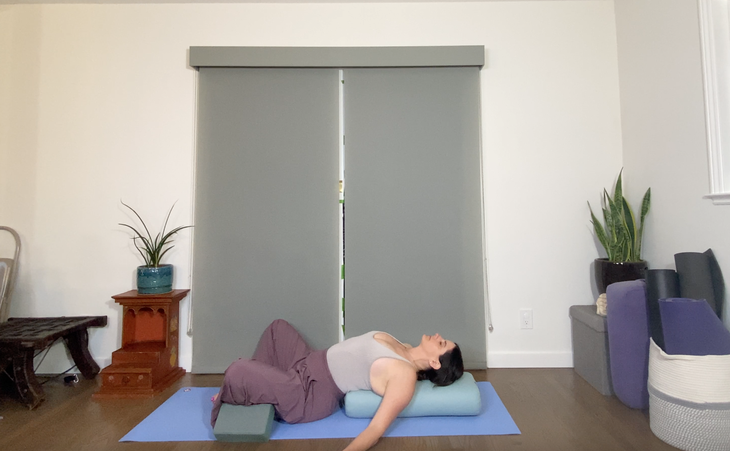
8. Supta Baddha Konasana (Reclining Bound Angle Pose)
A common tendency in using asana practice as an energizer is to sequence in nothing but strong, dynamic poses. But in order for your energy gains to be sustainable, you need to also take moments to pause and receive. This variation of Reclining Bound Angle Pose will serve as your Savasana, as well.
How to: Place a bolster or folded blankets vertically along the center of your mat. Create a pillow by folding a blanket and placing it perpendicular to the top of your bolster. Have two blocks handy. Sit in front of your bolster with your bum on the floor and your sacrum at the bolster's short edge. Lie back over the bolster, adjusting your "pillow" as needed. You’re welcome to stay here with legs straight. To add a little hip opening, bend your knees and open them out, bringing your soles together, and pulling your heels up toward your groin. Slide a block under each thigh and knee for less intensity. You can close your eyes and cover them, or gaze softly at the ceiling. Remain here quietly for 5 minutes or longer. To come out of the pose, bring your knees together. Pause and rest on the bolster for a few moments longer, then roll to one side. Use your hands for support to press up slowly, ensuring your head comes up last.
Pause in any comfortable seat and observe the effects of this practice. Take as long as you need in the pause, savoring this powerful resource of your energy, before diving back into your day.
About Our Contributor
Sarah Ezrin is an author, world-renowned yoga educator, popular Instagram influencer, and mama based in the San Francisco Bay Area. Her willingness to be unabashedly honest and vulnerable along with her innate wisdom make her writing, yoga classes, and social media great sources of healing and inner peace for many people. Sarah is changing the world, teaching self-love one person at a time. She is also the author of The Yoga of Parenting. You can follow her on Instagram at @sarahezrinyoga and TikTok at @sarahezrin.
For exclusive access to all of our fitness, gear, adventure, and travel stories, plus discounts on trips, events, and gear, sign up for Outside+ today.

